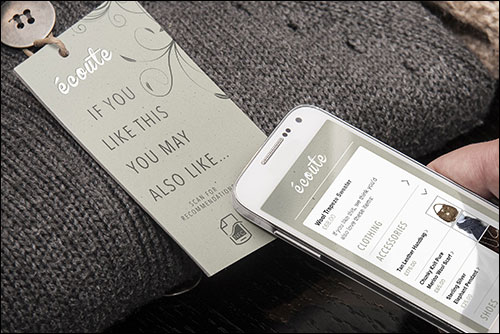Approximately a dozen companies in the United States and Europe have begun testing a paper product with integrated Near Field Communication (NFC) RFID tags. The product, known as PowerCoat Alive, is being offered by Arjowiggins Creative Papers. PowerCoat Alive is intended to provide users with uniform NFC-tagged paper sheets that they could then modify as necessary for use on packaging, labels, business cards or other paper-based products that they wish to track electronically.
Arjowiggins is one of the largest paper manufacturers worldwide, with about 5,000 employees. It has three divisions, including Creative Papers, which makes paper for very specific purposes, such as labels, book covers and brochures.

About two years ago, the French paper company launched the PowerCoat series of paper products designed for printed electronics applications (see Arjowiggins Creative Papers Showcases New Paper Substrate Ideal for RFID Antennas). In launching the PowerCoat series, the company aimed to enable the building of various electronic circuits into paper, to allow paper to be uniquely identified or store data digitally. The firm did not embed the electronic circuits itself; rather, Arjowiggins provided the paper to printed electronics companies so they could embed tags on it, with a tag antenna printed directly on the paper. The firm has found that NFC RFID inlays are among the more commonly requested electronic circuit applications, and has subsequently focused its development efforts on RFID-based products.
PowerCoat was the result of approximately five years worth of research and development, says Michael Carlisle, Arjowiggins’ business development manager for North America. Traditionally, he explains, printed electronics consist of a substrate made of PET (polyester) or other type of plastic on which conductive silver ink is applied and then heated, in a process known as sintering, to bond the ink molecules and make the printed antenna more conductive. The shortcoming with this process is that the plastic substrate can sustain heat only up to about 160 degrees Celsius (320 degrees Fahrenheit). A higher temperature would enable the use of less ink while also affording greater conductivity. Therefore, Arjowiggins Creative Papers developed a paper substrate that allows temperatures of up to 220 degrees Celsius (428 degrees Fahrenheit), leading to the need for approximately 25 percent less silver ink for each tag, and improving the product’s biodegradability.
Potential users, such as brand owners, retailers and product manufacturers, began looking into the use of this product, though Carlisle says he cannot discuss them, due to nondisclosure agreements. He does say, however, that in most applications, he envisions the product being used for brand protection or loyalty. In the case of brand protection, companies could have their own labels made with PowerCoat paper. Each built-in NFC tag would be encoded with a unique ID number that could be used to verify the authenticity of a high-value item, such as a designer bag or expensive liquor. A shopper or retailer could then simply use his or her own NFC-enabled smartphone, as well as an app provided by the brand company, to read the tags and confirm that each item is authentic prior to a purchase being made. Brand loyalty is another application for the product, allowing a consumer to tap an NFC-enabled phone against a tag, not only to ensure that it is not a counterfeit, but also, for instance, to register the product upon buying it, or to learn more information about it, or receive a discount on its price.
Companies can simply buy RFID-enabled sheets of paper from Arjowiggins, and then print text or graphics on those sheets and cut them as needed for their own use case, such as business cards, price tags or small packaging. If companies chose to do so, they could laminate the sheets to their own paper packaging.
Arjowiggins is using silicon NFC RFID chips from a variety of vendors, and is employing the services of a European printing company that places the ICs within the paper fibers and prints the antennas. Carlisle says he is in discussions with several potential partners in the United States that would provide similar services to allow North American customers to receive the printed sheets more quickly, once they place their orders.
A PowerCoat Alive sheet of paper measures 46 centimeters by 36 centimeters (18.1 inches by 14.17 inches), and can be ordered with either two or 25 NFC tags integrated into it. A box of PowerCoat Alive paper (containing four sheets with 25 tags apiece, or 30 sheets with two NFC tags apiece) costs about €90 euros ($100).
The PowerCoat Alive product is commercially available now. The technology is still being tested by potential customers, Carlisle says, but he expects the first sales to take place next month.
Although PowerCoat is strictly a high-frequency (HF) NFC RFID product, some companies are interested in using ultrahigh-frequency (UHF) RFID tags to accomplish a read at a greater distance than the few inches typically provided by NFC. Carlisle cites a pilot currently underway in New York in which a jewelry company (that has asked to be unnamed) is using envelopes made of PowerCoat paper. During a typical workday, the gems are placed in an envelope and are moved around the company’s facility as they are processed for use in jewelry, such as rings, pendants or bracelets. With the UHF RFID tags built into the envelopes, management could then utilize a handheld reader to locate all of them at any given time, in order to ensure that nothing is ever unaccounted for and, more generally, to manage workflow and inventory.

